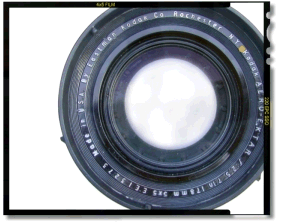 |

|
Radioactivity
Many rumors circulate on the internet about radioactivity of the Kodak Aero Ektar.
A further indication that Aero-Ektars are reasonably safe (nothing is perfectly safe) is that their possession by ordinary persons, i.e., persons without a radiation license, is legal in the United States. Title 10, Chapter I, Part 40, Section 13 of the Code of Federal Regulations says in part:
Any person is exempt from the regulations in this part and from the requirements for a license set forth in section 62 of the Act to the extent that such person receives, possesses, uses, transfers or delivers source material in ...... (7) Thorium contained in finished optical lenses, provided that each lens does not contain more than 30 percent by weight of thorium; and that the exemption contained in this subparagraph shall not be deemed to authorize either: (i) The shaping, grinding or polishing of such lens or manufacturing processes other than the assembly of such lens into optical systems and devices without any alteration of the lens; or (ii) The receipt, possession, use, transfer, or [sic: the original is missing a word] of thorium contained in contact lenses, or in spectacles, or in eyepieces in binoculars or other optical instruments. Two elements of the f2.5 Aero-Ektars are made of glass with 11% and 13% Thorium by weight, so this regulation clearly allows possession of Aero-Ektars. The most basic principle of radiation safety is that radiation exposure should be lowered to the minimum practical level. Regardless of safety calculations, the level of radiation exposure should be further reduced if there is a practical means to do so. This means keeping people far away (many yards/meters) from Aero-Ektars except when one is being used or examined. Of course, in their original war time use, the danger of the radiation from Aero-Ektars was utterly trivial compared to the more obvious risks that America's soldiers, sailors and aviators took in order to win the war. The substitution of night-time reconnaissance flights for daytime flights made possible by the fast aperture of the f2.5 Aero-Ektars undoubtedly saved American lives.
|

|
Report from a user:
in a message dated 10/23/2005 4:57:19 AM Hawaiian Standard Time, jd.esq@tiscali.nl writes:
Dear Dan,
Hi John.
Regards, Dan |
 Legal! Legal!
 About About
 Whois Whois
 Aldis Aldis
 Aero Project Aero Project
 The Workout The Workout
 Memorandum Memorandum
 Encounter... Encounter...
 Graflens Graflens
 Lenses+ Lenses+
 Holes+ Holes+
 My Pacemaker SG's My Pacemaker SG's
 Books Books
 Graflinks Graflinks
 Speedlights Speedlights
 Gallery Gallery
 WICF WICF
 Contact Contact
 Filmholders Filmholders
 Start Page Start Page
 Whatsnew Whatsnew
|